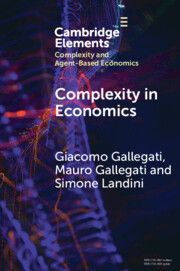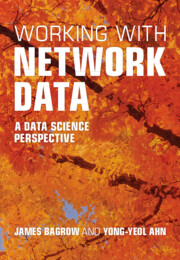Refine search
Actions for selected content:
97 results
5 - Multiple Roads to Pathology
- from Part II - Contemporary Approaches to Traditional Conceptual Perspectives
-
-
- Book:
- Conceptualizing Personality Disorder
- Published online:
- 25 June 2025
- Print publication:
- 10 July 2025, pp 86-107
-
- Chapter
- Export citation
14 - Network Architectures of Personality and Its Pathology
- from Part III - Novel Conceptual Approaches to Personality Disorder
-
-
- Book:
- Conceptualizing Personality Disorder
- Published online:
- 25 June 2025
- Print publication:
- 10 July 2025, pp 244-260
-
- Chapter
- Export citation
Complex Earth–outer space systems and new spacetime for international law
-
- Journal:
- International Journal of Law in Context / Volume 21 / Issue 2 / June 2025
- Published online by Cambridge University Press:
- 20 June 2025, pp. 300-313
-
- Article
-
- You have access
- Open access
- HTML
- Export citation
Designing value-robust circular systems through changeability: a framework with case studies
- Part of
-
- Journal:
- Design Science / Volume 11 / 2025
- Published online by Cambridge University Press:
- 13 May 2025, e15
-
- Article
-
- You have access
- Open access
- HTML
- Export citation
New diagnosis in psychiatry: beyond heuristics
-
- Journal:
- Psychological Medicine / Volume 55 / 2025
- Published online by Cambridge University Press:
- 06 February 2025, e26
-
- Article
-
- You have access
- Open access
- HTML
- Export citation
By Way of Introduction
-
- Book:
- Contesting Pluralism(s)
- Published online:
- 19 December 2024
- Print publication:
- 02 January 2025, pp 1-2
-
- Chapter
- Export citation
Spatial analysis of tails of air pollution PDFs in Europe
- Part of
-
- Journal:
- Environmental Data Science / Volume 3 / 2024
- Published online by Cambridge University Press:
- 02 January 2025, e30
-
- Article
-
- You have access
- Open access
- HTML
- Export citation
2 - Pluralizers and Anti-Pluralists
- from Part I - Theory
-
- Book:
- Contesting Pluralism(s)
- Published online:
- 19 December 2024
- Print publication:
- 02 January 2025, pp 30-58
-
- Chapter
- Export citation
Possible Futures for Network Psychometrics
-
- Journal:
- Psychometrika / Volume 87 / Issue 1 / March 2022
- Published online by Cambridge University Press:
- 01 January 2025, pp. 253-265
-
- Article
-
- You have access
- Open access
- HTML
- Export citation
Introduction: Structure Matters
-
- Book:
- Behavioral Network Science
- Published online:
- 08 November 2024
- Print publication:
- 19 December 2024, pp 1-8
-
- Chapter
- Export citation
13 - Climate Change and the Arctic: A Study of Paradoxical Linkages in Complex Systems
- from Part II - Designing Effective Governance Mechanisms
-
-
- Book:
- Implementing Climate Change Policy
- Published online:
- 22 November 2024
- Print publication:
- 05 December 2024, pp 216-230
-
- Chapter
-
- You have access
- Open access
- HTML
- Export citation
13 - A Systems View of Small-Group Behavior
- from Part IV - Groups and the Organization
-
- Book:
- Groups
- Published online:
- 12 December 2024
- Print publication:
- 05 December 2024, pp 285-305
-
- Chapter
- Export citation

Complexity in Economics
-
- Published online:
- 02 December 2024
- Print publication:
- 02 January 2025
-
- Element
- Export citation
14 - Simulating Religion
- from Part III - Religious Studies
-
-
- Book:
- The Cambridge Companion to Religion and Artificial Intelligence
- Published online:
- 20 November 2024
- Print publication:
- 21 November 2024, pp 241-256
-
- Chapter
- Export citation
16 - Epidemiology and the public’s health
-
- Book:
- Essential Epidemiology
- Published online:
- 27 September 2024
- Print publication:
- 12 November 2024, pp 366-380
-
- Chapter
- Export citation
Evolutionary biology as a frontier for research on misinformation
-
- Journal:
- Politics and the Life Sciences / Volume 44 / Issue 1 / Spring 2025
- Published online by Cambridge University Press:
- 30 October 2024, pp. 139-141
-
- Article
-
- You have access
- HTML
- Export citation
Chapter 1 - A whirlwind tour of network science
- from Part I - Background
-
- Book:
- Working with Network Data
- Published online:
- 06 June 2024
- Print publication:
- 13 June 2024, pp 3-16
-
- Chapter
-
- You have access
- Export citation

Working with Network Data
- A Data Science Perspective
-
- Published online:
- 06 June 2024
- Print publication:
- 13 June 2024
Large language models in complex system design
-
- Journal:
- Proceedings of the Design Society / Volume 4 / May 2024
- Published online by Cambridge University Press:
- 16 May 2024, pp. 2197-2206
-
- Article
-
- You have access
- Open access
- Export citation
Incorporating transition design in the education of an established design subject to empower design students with systems thinking
-
- Journal:
- Proceedings of the Design Society / Volume 4 / May 2024
- Published online by Cambridge University Press:
- 16 May 2024, pp. 2785-2794
-
- Article
-
- You have access
- Open access
- Export citation











